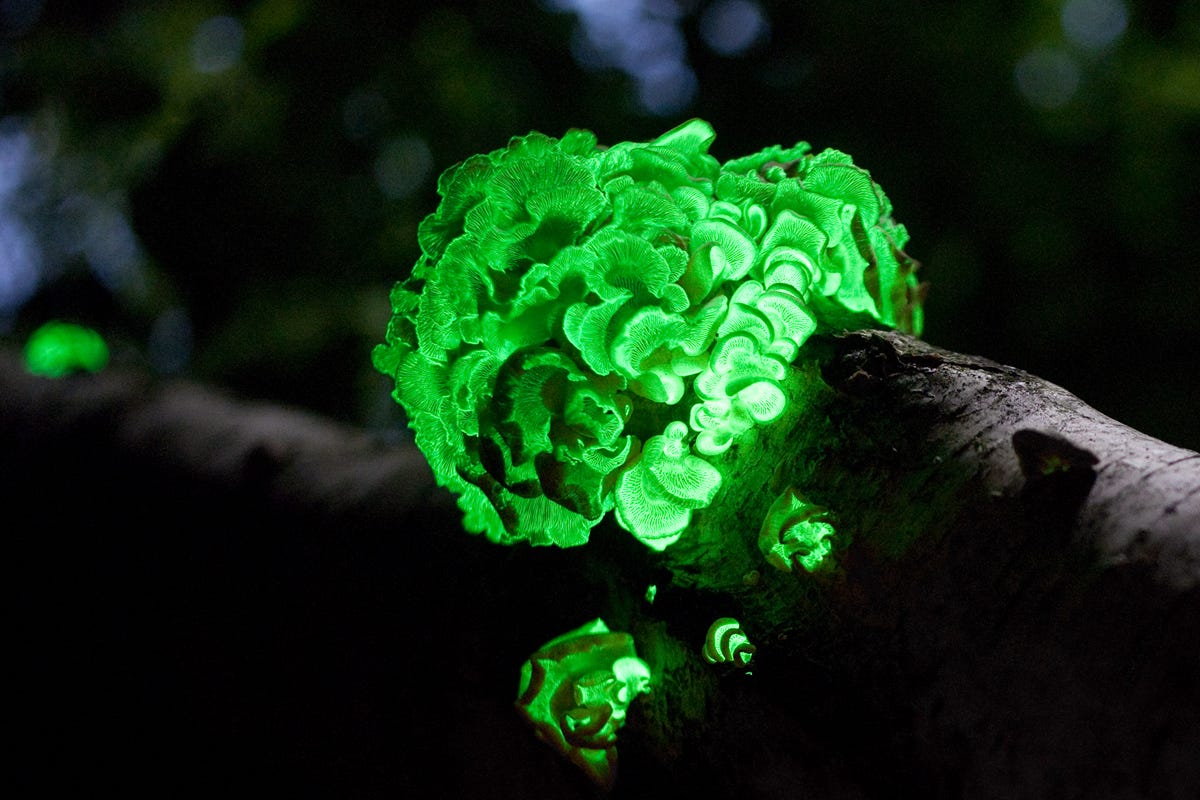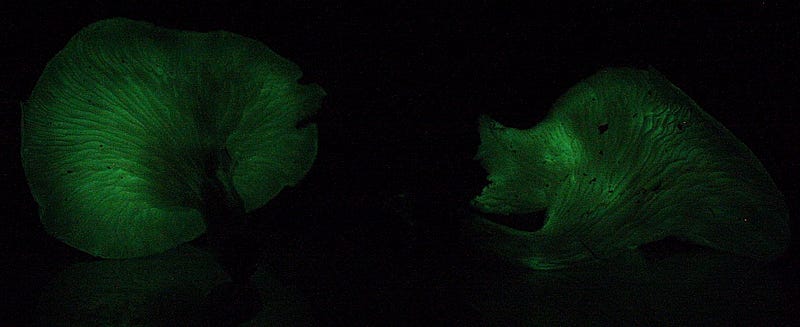
Our first story on bioluminescence starts in the realm of folklore, myth, and superstition around 2,400 years ago. This is the oldest documentation of a phenomenon that was likely known about going even further back. The philosopher Aristotle noted that some wood could be seen to glow at night, but was still cool to the touch. This glow eventually became known as ‘foxfire’. It is bluish-green in color and is most commonly seen on decaying wood. It is not usually as bright as the above photograph (which was achieved through a 517 second camera exposure), but there have been some instances where it is widespread and bright enough to actually read by.
It was also called ‘fairy fire’ and occasionally connected with folklore regarding a similar phenomenon referred to as a ‘will-o’-the-wisp’, a supernatural light thought to mislead travelers by resembling a flickering candle or lantern. A traveler coming across a patch of foxfire at night, especially if they had never encountered it before, could be forgiven for overreacting as it can be quite spooky to behold.
Of course, over the centuries it became clearer that the light was not supernatural in origin at all. In the late 18th century, it was used to illuminate the navigational instruments of the first submerged vehicle used in combat: the Turtle, an early prototype single-occupant submarine made of oak held together with steel bands with the mechanisms made of brass. It was made in an effort to covertly attach explosives to the undersides of British ships during the Revolutionary War, but failed in all attempts. It could not use conventional lighting of the time because there was no way to vent the toxic smoke while underwater. Also of note was that the foxfire failed and went dark when the temperature dropped below a certain point.
About fifty years later, in 1823, the actual source of the phenomenon was finally confirmed. After analyzing the glowing wooden support beams in mines, the light was found to be emanating from fungi growing on the wood. Over 75 species of bioluminescent fungi are currently known and found throughout the world in both tropical and temperate climates. All of them digest decaying wood, though some grow on already dead or dying plants while others are actually parasitic and will attack and consume living trees.

Why did the foxfire go dark on the Turtle at colder temperatures? And why are there no bioluminescent fungi in arctic or sub-arctic ecosystems? The answer lies in the process of bioluminescence itself. If you recall from last week, it is a chemical reaction catalyzed by an enzyme. As temperature decreases, the rate of chemical reactions slows. At very low temperatures, it can even interfere with the shape and structure of enzymes, preventing them from functioning and slowing the reaction rate even further. This decreased reaction rate means that fewer electrons are being transferred and less light is being emitted.

What is the purpose of bioluminescence in fungi? Unlike with other organisms, which we will explore later this season, the exact function and purpose of light emitting fungi is still not fully understood. There are some hypotheses, including attraction or deterrence of grazing organisms (depending on the structures that glow, as grazing on some parts can actually disperse spores and thus spread the fungus farther). There is also speculation that it can mitigate the damage caused by oxygen-based free radicals that are produced during the process of wood decay because of the oxygen-dependent nature of the bioluminescent chemical reaction.
Of course, even now we can’t fully detach ourselves from the folkloric origins of foxfire. Many of the fungi have been given spooky sounding names. For example, the species directly above, Omphalotus nidiformis, is also known as the ghost fungus. In my opinion, this isn’t really a reflection of humanity’s credulity, but rather an acknowledgement of our mutual enjoyment of stories. Stories are the medium through which we understand the world around us. Some may argue that by explaining phenomena like foxfire, we remove the mystery and excitement from nature, but I disagree. I believe that both scary stories and nature stories are important for our enjoyment. Both have the ability to capture our imagination, just in different ways. The ghost story isn’t about how the world works, but a reflection of our emotions and fears. They can drive us to discover how much those feelings are warranted. Without the story of foxfire, we wouldn’t have been as interested in studying the glowing wood and determining its actual cause.
Foxfire is a fascinating phenomenon overall to me, and hopefully to you all as well. Each of the species or groups that we’ll be looking at throughout Season 8 is an exercise in discovery. Bioluminescence has developed dozens of times and each time its particular form and purpose is slightly different. I hope that you will enjoy the journey with me. As always, if you enjoy my writing, please like, share, and leave a comment. I am always endeavoring to improve myself, so your suggestions are appreciated.